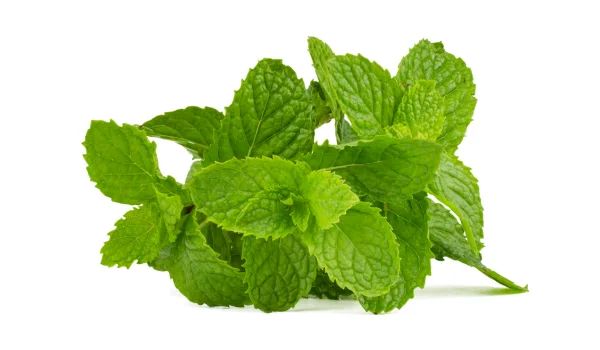Maybe. It depends on the type of mint. Most varieties of mint, like peppermint and spearmint, are safe for dogs in small amounts and can even be found in some dog treats and dental products because of their breath-freshening and digestion-aiding benefits. However, dogs should only consume a leaf or two occasionally—eating too much mint can lead to stomach upset, including vomiting or diarrhea.
That said, not all mint is safe. One variety, English pennyroyal, is toxic to dogs and can cause severe health issues. This plant grows in various parts of the United States, especially in temperate climates. If your dog shows signs of vomiting, diarrhea, or unusual weakness after eating mint, contact your veterinarian right away.
What Is Mint, and Why Do Dogs Like It?

Mint is a fragrant herb known for its refreshing aroma and cool taste. Common varieties include peppermint and spearmint, both widely used in teas, desserts, and even household products like gum and toothpaste. Dogs are naturally curious about mint because of its strong scent and distinct flavor, which can catch their attention. Since mint is so popular in human foods and products, it’s easy for dogs to come across it—whether it’s in your garden, on your plate, or in a treat you’re enjoying!
Can My Dog Eat Mint?
Yes, in small amounts, most mint varieties are safe for dogs, but it depends on the type of mint.
Spearmint and peppermint are generally safe and are even found in some dog treats and food to help freshen breath and support digestion. However, dogs should eat no more than a few leaves per day, as overconsumption can lead to gastrointestinal distress, including vomiting or diarrhea.
One variety to watch out for is English pennyroyal, which is toxic to dogs. This plant grows in many parts of the United States, except for the coldest regions, and can cause severe health issues if ingested. If your dog shows signs of vomiting, diarrhea, or weakness after eating mint, contact your veterinarian immediately. Moderation and the right type of mint are key to keeping your pup safe!
Read More: Can Dogs Eat Whipped Cream? The Answer May Surprise You!
Which Types of Mint Are Unsafe for Dogs?
The only type of mint that is toxic to dogs is pennyroyal mint, which can cause serious health issues like liver damage if ingested. This variety should always be avoided. Additionally, be cautious about giving your dog any mint plants that have been treated with pesticides or chemicals, as these can also be harmful. Always ensure the mint you offer is safe and free from toxic substances.
Health Benefits of Mint for Dogs
Mint offers a few positive benefits for dogs when given in small amounts. It can naturally freshen breath, helping with minor bad breath issues. Mint may also aid digestion, soothing mild stomach discomfort. Additionally, it contains antioxidants that can support overall health by fighting free radicals. However, always feed mint in moderation to avoid any potential side effects.
Potential Risks of Dogs Eating Mint
Is mint bad for dogs? In some cases, yes. Overconsumption can lead to digestive upset like vomiting or diarrhea, and some dogs may have allergic reactions to mint. Be cautious of mint products like gum, candy, or toothpaste, as they often contain xylitol, a toxic ingredient for dogs that can cause life-threatening health issues.
Read More: Can My Dog Eat Grits? Safe Treat or Risky Choice?
Can Dogs Eat Mint Leaves or Mint Products?
When it comes to mint, not all forms are created equal—some are safe for your dog, while others can be harmful or even toxic.
- Fresh Mint Leaves: Safe in small amounts as an occasional treat.
- Mint-Flavored Dog Treats: Generally safe if designed specifically for dogs.
- Mint Gum, Candy, or Toothpaste: Dangerous for dogs due to the risk of xylitol poisoning.
- Mint Tea: Safe if it’s caffeine-free, unsweetened, and given in moderation.
How Much Mint Can Dogs Eat?
Dogs should only eat 1–2 fresh mint leaves occasionally as a treat. Avoid daily consumption or large quantities, as this can upset your dog’s stomach.
Read More: Can Dogs Eat Dill? Benefits, Risks, and Vet-Approved Tips
What Should You Do if Your Dog Eats Too Much Mint?
If your dog eats too much mint, watch for symptoms like vomiting, diarrhea, or lethargy.
Action steps:
- Remove any leftover mint or toxic product.
- Monitor your dog closely for symptoms.
- Contact your vet immediately if your dog shows signs of distress.
Read More: Can Dogs Eat Ice Pops? Everything You Need to Know
Safe Alternatives to Mint for Dogs
Looking for dog-friendly herbs? Try these safe alternatives:
- Parsley: Freshens breath and aids digestion.
- Basil: Packed with mild health benefits.
- Cilantro: A vitamin-rich herb that’s safe in small amounts.
Read More: Can Dogs Eat Apricots? What You Need to Know
How to Add Mint Safely to Your Dog’s Diet
- Chop up 1 small leaf and mix it into your dog’s food occasionally.
- Use vet-approved, mint-flavored dog treats designed for dogs.
- Avoid human mint products containing xylitol or other harmful ingredients.
FAQs About Dogs and Mint
- Can dogs eat peppermint leaves? Yes, in moderation.
- What happens if a dog eats mint gum? Gum often contains xylitol, which is toxic—call your vet immediately.
- Can mint help with a dog’s bad breath? Yes, fresh mint leaves can help freshen breath.
- Is spearmint better than peppermint for dogs? Both are safe, but moderation is key.
- Can puppies eat mint? It’s best to avoid mint for puppies until consulting with your vet.
Conclusion
Yes, dogs can eat mint in small amounts, but only certain varieties like spearmint or peppermint are safe. Moderation is crucial to prevent side effects like stomach upset, and pennyroyal mint must always be avoided due to its toxicity. Before introducing mint or any new food to your dog’s diet, consult your veterinarian to ensure it’s the right choice for your furry friend.



















 English (US) ·
English (US) ·